2022 KIA NIRO HYBRID EV ECO mode
[x] Cancel search: ECO modePage 484 of 684
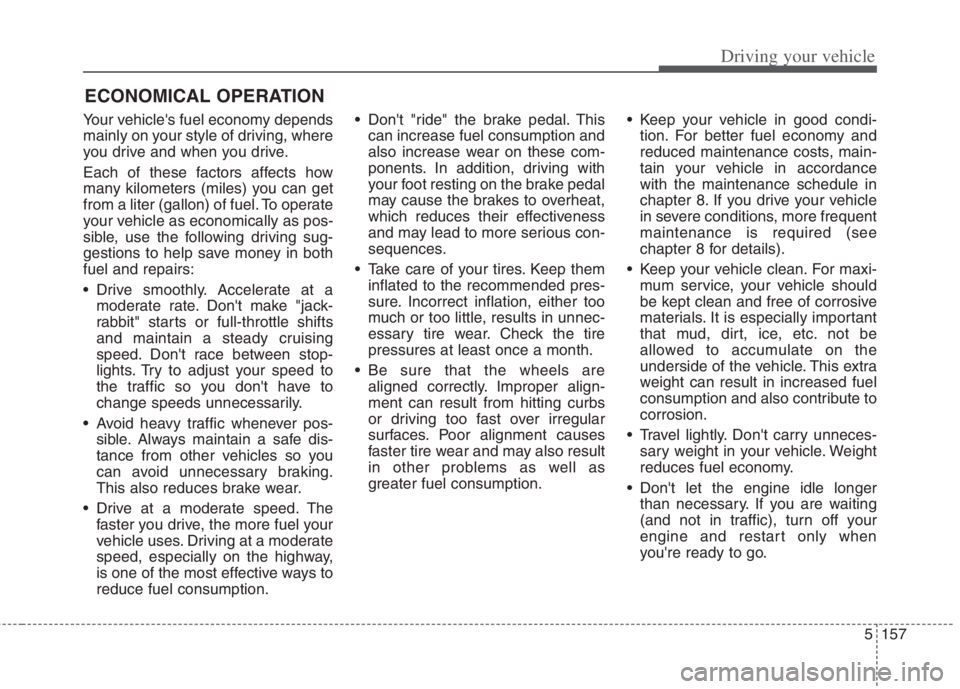
5157
Driving your vehicle
Your vehicle's fuel economy depends
mainly on your style of driving, where
you drive and when you drive.
Each of these factors affects how
many kilometers (miles) you can get
from a liter (gallon) of fuel. To operate
your vehicle as economically as pos-
sible, use the following driving sug-
gestions to help save money in both
fuel and repairs:
Drive smoothly. Accelerate at a
moderate rate. Don't make "jack-
rabbit" starts or full-throttle shifts
and maintain a steady cruising
speed. Don't race between stop-
lights. Try to adjust your speed to
the traffic so you don't have to
change speeds unnecessarily.
Avoid heavy traffic whenever pos-
sible. Always maintain a safe dis-
tance from other vehicles so you
can avoid unnecessary braking.
This also reduces brake wear.
Drive at a moderate speed. The
faster you drive, the more fuel your
vehicle uses. Driving at a moderate
speed, especially on the highway,
is one of the most effective ways to
reduce fuel consumption. Don't "ride" the brake pedal. This
can increase fuel consumption and
also increase wear on these com-
ponents. In addition, driving with
your foot resting on the brake pedal
may cause the brakes to overheat,
which reduces their effectiveness
and may lead to more serious con-
sequences.
Take care of your tires. Keep them
inflated to the recommended pres-
sure. Incorrect inflation, either too
much or too little, results in unnec-
essary tire wear. Check the tire
pressures at least once a month.
Be sure that the wheels are
aligned correctly. Improper align-
ment can result from hitting curbs
or driving too fast over irregular
surfaces. Poor alignment causes
faster tire wear and may also result
in other problems as well as
greater fuel consumption. Keep your vehicle in good condi-
tion. For better fuel economy and
reduced maintenance costs, main-
tain your vehicle in accordance
with the maintenance schedule in
chapter 8. If you drive your vehicle
in severe conditions, more frequent
maintenance is required (see
chapter 8 for details).
Keep your vehicle clean. For maxi-
mum service, your vehicle should
be kept clean and free of corrosive
materials. It is especially important
that mud, dirt, ice, etc. not be
allowed to accumulate on the
underside of the vehicle. This extra
weight can result in increased fuel
consumption and also contribute to
corrosion.
Travel lightly. Don't carry unneces-
sary weight in your vehicle. Weight
reduces fuel economy.
Don't let the engine idle longer
than necessary. If you are waiting
(and not in traffic), turn off your
engine and restart only when
you're ready to go.
ECONOMICAL OPERATION
Page 504 of 684
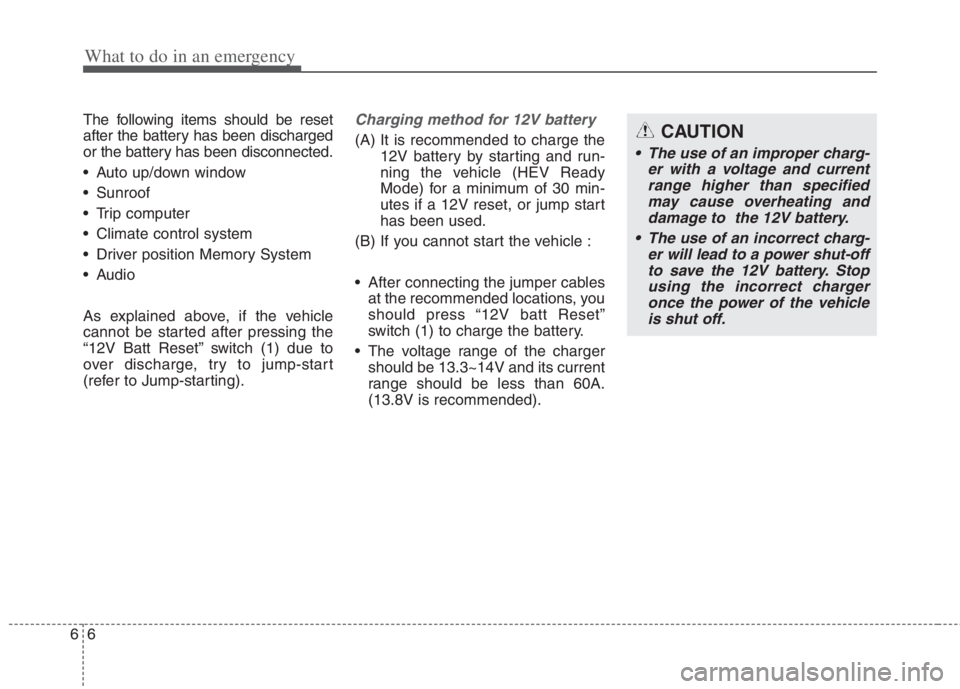
What to do in an emergency
6 6
The following items should be reset
after the battery has been discharged
or the battery has been disconnected.
Auto up/down window
Sunroof
Trip computer
Climate control system
Driver position Memory System
Audio
As explained above, if the vehicle
cannot be started after pressing the
“12V Batt Reset” switch (1) due to
over discharge, try to jump-start
(refer to Jump-starting).Charging method for 12V battery
(A) It is recommended to charge the
12V battery by starting and run-
ning the vehicle (HEV Ready
Mode) for a minimum of 30 min-
utes if a 12V reset, or jump start
has been used.
(B) If you cannot start the vehicle :
After connecting the jumper cables
at the recommended locations, you
should press “12V batt Reset”
switch (1) to charge the battery.
The voltage range of the charger
should be 13.3~14V and its current
range should be less than 60A.
(13.8V is recommended).CAUTION
• The use of an improper charg-
er with a voltage and current
range higher than specified
may cause overheating and
damage to the 12V battery.
The use of an incorrect charg-
er will lead to a power shut-off
to save the 12V battery. Stop
using the incorrect charger
once the power of the vehicle
is shut off.
Page 554 of 684

Maintenance
12 7
Number of months or driving distance, whichever comes first
Months1224364860728496108120132144156168180
Miles×1,0007.51522.530 37.5 45 52.5 60 67.5 75 82.5 90 97.5 105 112.5
Km×1,00012 24 36 48 60 72 84 96 108 120 132 144 156 168 180
All latch, hinges and locksInspect every 24,000 km (15,000 miles) or 12 months
Cooling system---I-I-I-I-I-I-
Fuel lines, hoses and connections---I---I---I---
Dual clutch transmission fluid----I----I----I
MAINTENANCE
INTERVALS
MAINTENANCE
ITEM
Normal Maintenance Schedule - Non Turbo Models (CONT.)
I : Inspect and if necessary, adjust, correct, clean or replace.
R : Replace or change.
*1: If TOP TIER Detergent Gasoline is not available, one bottle of additive is recommended. Additives are available from your author-
ized Kia dealer along with information on how to use them. Do not mix other additives.
*2: As it is normal for engine oil to be consumed during driving, the engine oil level should be checked on regular basis. The engine
oil change interval for normal operating conditions is based on the use of the recommended engine specification. If the recom-
mended engine oil specification is not used, then replace the engine oil according to the maintenance schedule under severe
operating conditions.
*3: Inspect HSG belt for evidence of cuts, cracks, excessive wear or oil saturation and replace if necessary. If HSG belt noise
occurred, readjust HSG belt tension before replace.
*4: Fuel tank air filter are considered to be maintenance free but periodic inspection is recommended for this maintenance sched-
ule depends on fuel quality.
Page 596 of 684
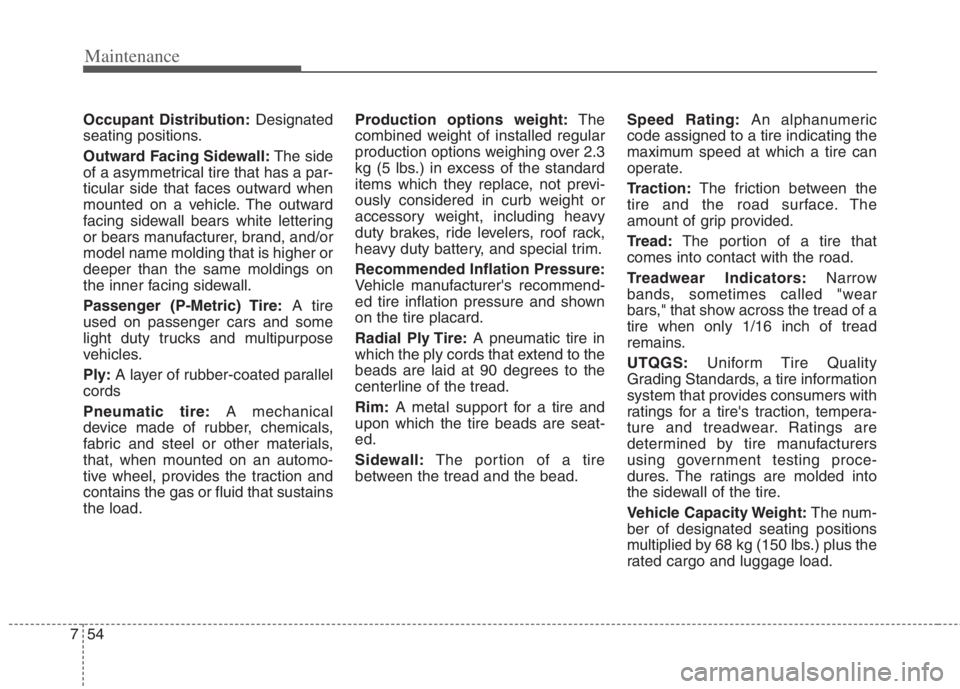
Maintenance
54 7
Occupant Distribution:Designated
seating positions.
Outward Facing Sidewall:The side
of a asymmetrical tire that has a par-
ticular side that faces outward when
mounted on a vehicle. The outward
facing sidewall bears white lettering
or bears manufacturer, brand, and/or
model name molding that is higher or
deeper than the same moldings on
the inner facing sidewall.
Passenger (P-Metric) Tire:A tire
used on passenger cars and some
light duty trucks and multipurpose
vehicles.
Ply:A layer of rubber-coated parallel
cords
Pneumatic tire:A mechanical
device made of rubber, chemicals,
fabric and steel or other materials,
that, when mounted on an automo-
tive wheel, provides the traction and
contains the gas or fluid that sustains
the load.Production options weight:The
combined weight of installed regular
production options weighing over 2.3
kg (5 lbs.) in excess of the standard
items which they replace, not previ-
ously considered in curb weight or
accessory weight, including heavy
duty brakes, ride levelers, roof rack,
heavy duty battery, and special trim.
Recommended Inflation Pressure:
Vehicle manufacturer's recommend-
ed tire inflation pressure and shown
on the tire placard.
Radial Ply Tire:A pneumatic tire in
which the ply cords that extend to the
beads are laid at 90 degrees to the
centerline of the tread.
Rim:A metal support for a tire and
upon which the tire beads are seat-
ed.
Sidewall:The portion of a tire
between the tread and the bead.Speed Rating:An alphanumeric
code assigned to a tire indicating the
maximum speed at which a tire can
operate.
Traction:The friction between the
tire and the road surface. The
amount of grip provided.
Tread:The portion of a tire that
comes into contact with the road.
Treadwear Indicators:Narrow
bands, sometimes called "wear
bars," that show across the tread of a
tire when only 1/16 inch of tread
remains.
UTQGS:Uniform Tire Quality
Grading Standards, a tire information
system that provides consumers with
ratings for a tire's traction, tempera-
ture and treadwear. Ratings are
determined by tire manufacturers
using government testing proce-
dures. The ratings are molded into
the sidewall of the tire.
Vehicle Capacity Weight:The num-
ber of designated seating positions
multiplied by 68 kg (150 lbs.) plus the
rated cargo and luggage load.
Page 597 of 684
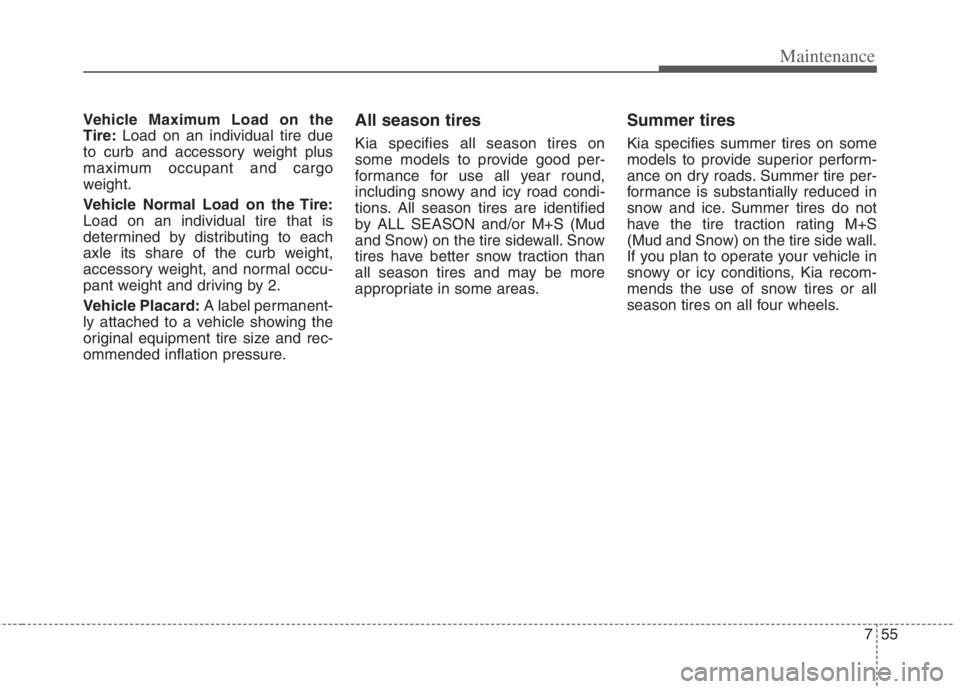
755
Maintenance
Vehicle Maximum Load on the
Tire:Load on an individual tire due
to curb and accessory weight plus
maximum occupant and cargo
weight.
Vehicle Normal Load on the Tire:
Load on an individual tire that is
determined by distributing to each
axle its share of the curb weight,
accessory weight, and normal occu-
pant weight and driving by 2.
Vehicle Placard:A label permanent-
ly attached to a vehicle showing the
original equipment tire size and rec-
ommended inflation pressure.All season tires
Kia specifies all season tires on
some models to provide good per-
formance for use all year round,
including snowy and icy road condi-
tions. All season tires are identified
by ALL SEASON and/or M+S (Mud
and Snow) on the tire sidewall. Snow
tires have better snow traction than
all season tires and may be more
appropriate in some areas.
Summer tires
Kia specifies summer tires on some
models to provide superior perform-
ance on dry roads. Summer tire per-
formance is substantially reduced in
snow and ice. Summer tires do not
have the tire traction rating M+S
(Mud and Snow) on the tire side wall.
If you plan to operate your vehicle in
snowy or icy conditions, Kia recom-
mends the use of snow tires or all
season tires on all four wheels.
Page 655 of 684
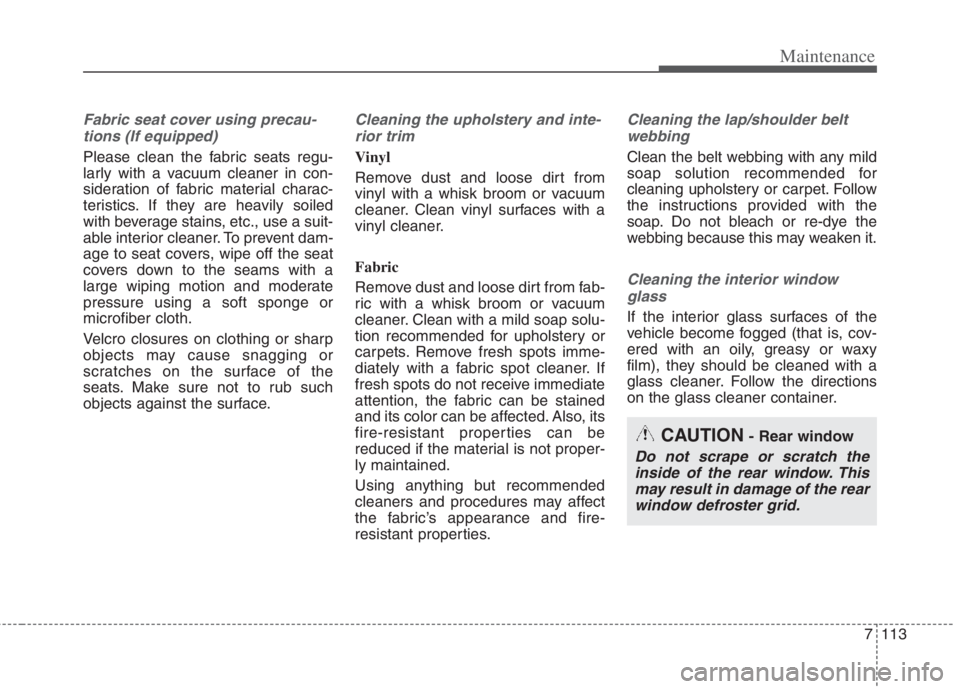
7113
Maintenance
Fabric seat cover using precau-
tions (If equipped)
Please clean the fabric seats regu-
larly with a vacuum cleaner in con-
sideration of fabric material charac-
teristics. If they are heavily soiled
with beverage stains, etc., use a suit-
able interior cleaner. To prevent dam-
age to seat covers, wipe off the seat
covers down to the seams with a
large wiping motion and moderate
pressure using a soft sponge or
microfiber cloth.
Velcro closures on clothing or sharp
objects may cause snagging or
scratches on the surface of the
seats. Make sure not to rub such
objects against the surface.
Cleaning the upholstery and inte-
rior trim
Vinyl
Remove dust and loose dirt from
vinyl with a whisk broom or vacuum
cleaner. Clean vinyl surfaces with a
vinyl cleaner.
Fabric
Remove dust and loose dirt from fab-
ric with a whisk broom or vacuum
cleaner. Clean with a mild soap solu-
tion recommended for upholstery or
carpets. Remove fresh spots imme-
diately with a fabric spot cleaner. If
fresh spots do not receive immediate
attention, the fabric can be stained
and its color can be affected. Also, its
fire-resistant properties can be
reduced if the material is not proper-
ly maintained.
Using anything but recommended
cleaners and procedures may affect
the fabric’s appearance and fire-
resistant properties.
Cleaning the lap/shoulder belt
webbing
Clean the belt webbing with any mild
soap solution recommended for
cleaning upholstery or carpet. Follow
the instructions provided with the
soap. Do not bleach or re-dye the
webbing because this may weaken it.
Cleaning the interior window
glass
If the interior glass surfaces of the
vehicle become fogged (that is, cov-
ered with an oily, greasy or waxy
film), they should be cleaned with a
glass cleaner. Follow the directions
on the glass cleaner container.
CAUTION- Rear window
Do not scrape or scratch the
inside of the rear window. This
may result in damage of the rear
window defroster grid.
Page 682 of 684
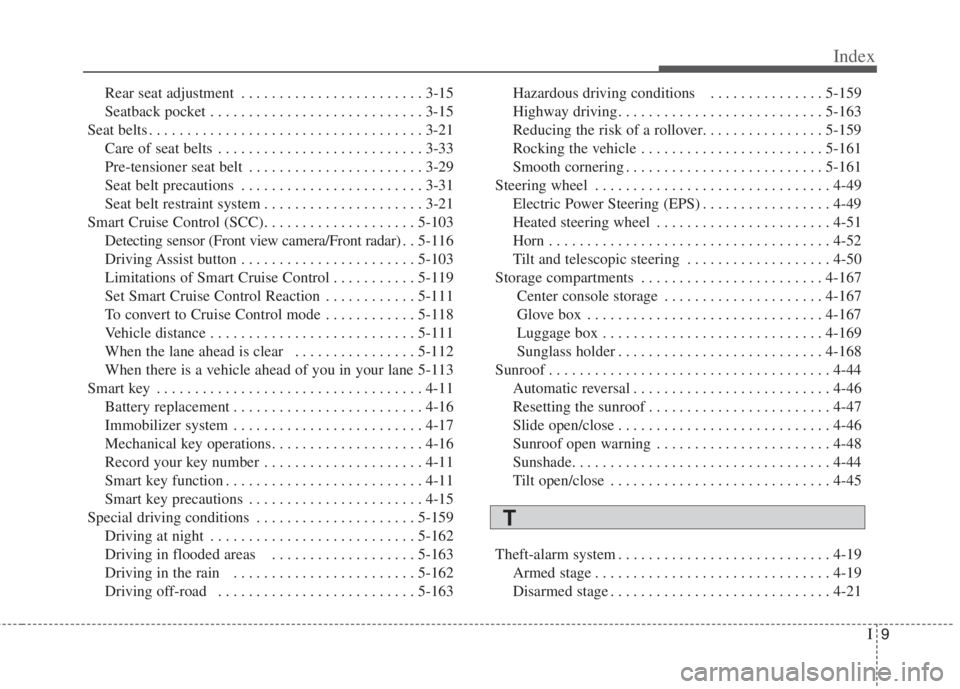
I9
Index
Rear seat adjustment . . . . . . . . . . . . . . . . . . . . . . . . 3-15
Seatback pocket . . . . . . . . . . . . . . . . . . . . . . . . . . . . 3-15
Seat belts . . . . . . . . . . . . . . . . . . . . . . . . . . . . . . . . . . . . 3-21
Care of seat belts . . . . . . . . . . . . . . . . . . . . . . . . . . . 3-33
Pre-tensioner seat belt . . . . . . . . . . . . . . . . . . . . . . . 3-29
Seat belt precautions . . . . . . . . . . . . . . . . . . . . . . . . 3-31
Seat belt restraint system . . . . . . . . . . . . . . . . . . . . . 3-21
Smart Cruise Control (SCC). . . . . . . . . . . . . . . . . . . . 5-103
Detecting sensor (Front view camera/Front radar) . . 5-116
Driving Assist button . . . . . . . . . . . . . . . . . . . . . . . 5-103
Limitations of Smart Cruise Control . . . . . . . . . . . 5-119
Set Smart Cruise Control Reaction . . . . . . . . . . . . 5-111
To convert to Cruise Control mode . . . . . . . . . . . . 5-118
Vehicle distance . . . . . . . . . . . . . . . . . . . . . . . . . . . 5-111
When the lane ahead is clear . . . . . . . . . . . . . . . . 5-112
When there is a vehicle ahead of you in your lane 5-113
Smart key . . . . . . . . . . . . . . . . . . . . . . . . . . . . . . . . . . . 4-11
Battery replacement . . . . . . . . . . . . . . . . . . . . . . . . . 4-16
Immobilizer system . . . . . . . . . . . . . . . . . . . . . . . . . 4-17
Mechanical key operations. . . . . . . . . . . . . . . . . . . . 4-16
Record your key number . . . . . . . . . . . . . . . . . . . . . 4-11
Smart key function . . . . . . . . . . . . . . . . . . . . . . . . . . 4-11
Smart key precautions . . . . . . . . . . . . . . . . . . . . . . . 4-15
Special driving conditions . . . . . . . . . . . . . . . . . . . . . 5-159
Driving at night . . . . . . . . . . . . . . . . . . . . . . . . . . . 5-162
Driving in flooded areas . . . . . . . . . . . . . . . . . . . 5-163
Driving in the rain . . . . . . . . . . . . . . . . . . . . . . . . 5-162
Driving off-road . . . . . . . . . . . . . . . . . . . . . . . . . . 5-163Hazardous driving conditions . . . . . . . . . . . . . . . 5-159
Highway driving . . . . . . . . . . . . . . . . . . . . . . . . . . . 5-163
Reducing the risk of a rollover. . . . . . . . . . . . . . . . 5-159
Rocking the vehicle . . . . . . . . . . . . . . . . . . . . . . . . 5-161
Smooth cornering . . . . . . . . . . . . . . . . . . . . . . . . . . 5-161
Steering wheel . . . . . . . . . . . . . . . . . . . . . . . . . . . . . . . 4-49
Electric Power Steering (EPS) . . . . . . . . . . . . . . . . . 4-49
Heated steering wheel . . . . . . . . . . . . . . . . . . . . . . . 4-51
Horn . . . . . . . . . . . . . . . . . . . . . . . . . . . . . . . . . . . . . 4-52
Tilt and telescopic steering . . . . . . . . . . . . . . . . . . . 4-50
Storage compartments . . . . . . . . . . . . . . . . . . . . . . . . 4-167
Center console storage . . . . . . . . . . . . . . . . . . . . . 4-167
Glove box . . . . . . . . . . . . . . . . . . . . . . . . . . . . . . . 4-167
Luggage box . . . . . . . . . . . . . . . . . . . . . . . . . . . . . 4-169
Sunglass holder . . . . . . . . . . . . . . . . . . . . . . . . . . . 4-168
Sunroof . . . . . . . . . . . . . . . . . . . . . . . . . . . . . . . . . . . . . 4-44
Automatic reversal . . . . . . . . . . . . . . . . . . . . . . . . . . 4-46
Resetting the sunroof . . . . . . . . . . . . . . . . . . . . . . . . 4-47
Slide open/close . . . . . . . . . . . . . . . . . . . . . . . . . . . . 4-46
Sunroof open warning . . . . . . . . . . . . . . . . . . . . . . . 4-48
Sunshade. . . . . . . . . . . . . . . . . . . . . . . . . . . . . . . . . . 4-44
Tilt open/close . . . . . . . . . . . . . . . . . . . . . . . . . . . . . 4-45
Theft-alarm system . . . . . . . . . . . . . . . . . . . . . . . . . . . . 4-19
Armed stage . . . . . . . . . . . . . . . . . . . . . . . . . . . . . . . 4-19
Disarmed stage . . . . . . . . . . . . . . . . . . . . . . . . . . . . . 4-21
T